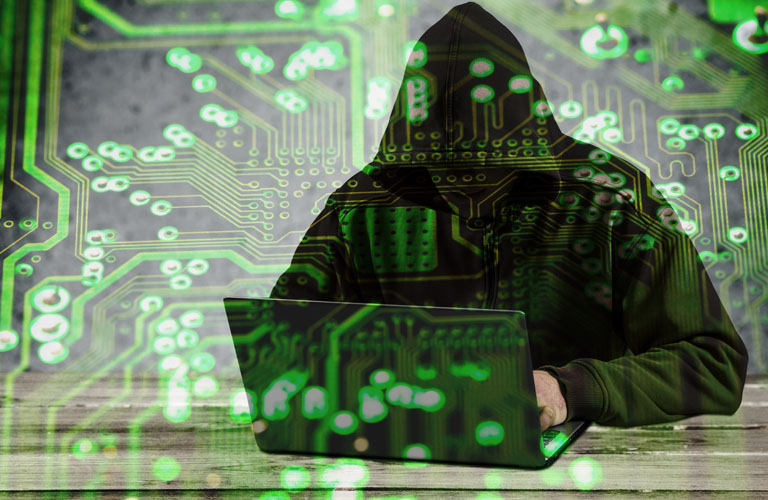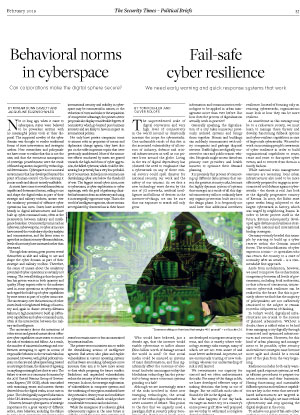Fail-safe cyber resilience: We need early warning and quick response systems that work

The unprecedented scale of digital conversion and very high level of connectivity in the world around us drastically increase the scope for cyberattacks. One undeniable result of this fact is the increased vulnerability of all sectors of industry, defense and critical infrastructures as well as our private lives around the globe. Living in the era of digital dependency has obviated the need to emphasize that a cyberattack on any of these critical sectors could spell disaster for national security, our work and the safety of our citizens. As we face a new technology wave driven by the rise of 5G networks, artificial intelligence and billions of devices in the internet-of-things, we can be sure that our exposure to attack will only grow.
Who would have believed, just a decade ago, that the internet would enable cybercrime to inflict almost $600 billion worth of damage around the world in 2018? Or that social media could be misused as systems of mass disinformation, and thus significantly affect the outcome of elections? And who can imagine today that blockchain technology has the potential to bring entire economic systems grinding to a halt?
Although we are increasingly aware of the risks involved in these new emerging technologies, the actual use of the technologies themselves is never a matter of debate. This points to the fact that we urgently need a paradigm shift in security policy. Security in the digital era is much more than an inconvenient cost factor or a field of action for technology freaks. It is something we have a pressing need for if we are to build sustainable cyber resilience into the potentials offered by digitalization. And it should play a role not only at the highest level of government, but also in the cities where we live.
Urbanization is proceeding apace. Experts forecast that more than two-thirds of the world’s population will live in cities by 2050. Urbanization is accompanied by far-reaching technological change that is increasingly encroaching on our lives. We are already living in a world that has seen itself transformed into a global village by digitalization. And this process is set to continue. If our cities are to keep pace with future needs and not end up drowning in dirt and trash, they must and they will become smart cities. In the future, sustainable urban development is going to need modern information and communication technologies to be applied in urban management more than ever before. But how does the process of digitalization actually work in practice?
Generally speaking, the digitalization of a city takes numerous previously isolated systems and brings them together. Homes and buildings
can suddenly communicate with utility companies and garbage disposal services. Traffic lights are digitally connected to cars and public transit vehicles. Hospitals might access data from primary care providers and health insurers to optimize their demand planning.
It is precisely this process of connecting up different data systems that carries the greatest security risks, because the highly dynamic system of systems that emerges as a result of all this digital connectivity will not ordinarily have any organic protection built into it in the design phase. It is frequently not until later that additional interfaces are developed to integrate security systems, and this is exactly where technology strategy risks emerge, many of which we are not even aware of and must better understand. At present, we are enormously trusting of new technology, whereas our understanding of risk is still limited.
We overestimate our capacity for control and we often underestimate the risks. For many of the things in life, we have developed effective ways of making decisions that keep us out of danger. But we still lack such rules of thumb for life in the digital age. But what happens if one day hackers target an entire city or a country’s entire power grid? How well prepared are we today to withstand a complete digital meltdown?
Without a doubt, more internet users, devices, connections and data flow mean that the risks will continue to grow and, in particular, to burden our critical infrastructures. At the same time, there are considerable concerns that we are neither prepared to handle these threats nor able to rely on fallback options. Indeed, we lack the capacity to even respond in the event of a large scale cyberattack. States, cities and their industries still fail to recognize that they are all potential targets for cyber attacks.
In real life, crises do not run on a timetable, and they are not linear. Cyber-risk resilience questions need to be answered in the here and now. And they must be answered for every government at a national and local level as well as for companies that work with digital processes and administrative structures, because it will not be possible to provide overarching cybersecurity and cyber-risk resilience. Instead of focusing only on resisting cyberattacks, organizations must look at how they can be more resilient.
As unwelcome as this message may be to a risk-averse society, we must learn to manage these threats and develop functioning fallback options and cyber-resilient capabilities in case of large-scale cyberattacks. We need to work on increasing people’s awareness of cyber resilience in order to build organizational capabilities to sense, resist and react to disruptive cyber events, and to recover from them in a timely fashion.
While national crisis management exercises are necessary, local urban infrastructures also need to be more effectively prepared to engage in interconnected civil defense against cyberattacks – the threat is real. Just look at the digitally progressive country of Estonia. In 2007, the Baltic state spent weeks being subjected to the largest cyberattack in history, which was waged by neighboring Russia. In order to better protect itself in the future, Estonia subsequently developed agile defense and resilience strategies with national and international backup strategies.
Germany recently heeded this example by starting to build up a cyber reserve within the German armed forces. The civil mobilization of cyber experts in a crisis – i.e. specialists who can return the country to a state of normalcy after an attack – is a commendable first approach.
Aside from mobilization, however, we need to improve the orchestration competency between all levels of governments, including local authorities, so that a form of continuous, citizen-centric cyber-risk resilience can be realized in the future. But this is precisely where we find that the majority of policymakers are not sufficiently sensitized to the subject or remain rooted in old patterns of thinking.
In today’s world, digitalized infrastructures are crucial to the success of planned urbanization. Without a doubt, there is added value to be had from managing a city digitally through connected and optimized infrastructures and services. However, for this kind of urban planning and management to be possible, cyber security and resilience strategies must become more agile and should be a crucial part of the plan from the very beginning.
Resilience includes both early warning and quick response systems, as well as efficient procedures to prepare our urban societies and their businesses. Having functioning and sustainable fallback options and resilience capabilities are key in the event that network-based infrastructures are targeted in an attack. In this light, we must rethink cybersecurity and stop ignoring the digital elephant in the room.
To achieve our goal of fail-safe cyber resilience, we need to engage in permanent and interdisciplinary dialogue with more clarity and with concrete actionable recommendations. We must take an innovative hands-on approach that creates adequate cyber resilience while at the same time not restricting our creativity and freedom. It goes without saying that organizational structures and cultures must also be adopted in order to cope with the dynamic and complexity outlined above. If local governments and their representatives understand these challenges and are successful in this endeavor, their citizens will feel more secure and understand that the risks do not outweigh the opportunities inherent in the new emerging technologies.
TOM KOEHLER is a founding partner and OLIVER ROLOFS a partner at connecting trust.




